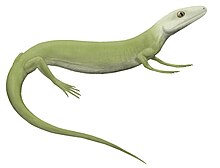Protorothyris
| Protorothyris Temporal range: Asselian,
| |
|---|---|

| |
| Scientific classification | |
| Domain: | Eukaryota |
| Kingdom: | Animalia |
| Phylum: | Chordata |
| Class: | Reptilia |
| Family: | †Protorothyrididae |
| Genus: | †Protorothyris Price, 1937 |
| Species | |
| Synonyms | |
|
Melanothyris Romer, 1952 | |
Protorothyris is an extinct genus of Early Permian protorothyridid known from Texas and West Virginia of the United States. It was first named by Llewellyn Ivor Price in 1937 and the type species is Protorothyris archeri. P. archeri is known from the holotype MCZ 1532, a three-dimensionally preserved skull and from the referred specimens, which come from four additional individuals, MCZ 2147-2150. All specimens were collected in the Cottonwood Creek site, from the Archer City Formation, Texas, dating to the Asselian stage of the Cisuralian epoch, about 299–294.6 million years ago.[1] A second species, P. morani, was first named by Alfred Sherwood Romer in 1952 with its own generic name, Melanothyris.[2] In 1973, J. Clark and Robert L. Carroll recombined P. morani as a Protorothyris species. It is known from the holotype CM 8617, a three-dimensionally preserved skull. It was collected in the Blacksville site, from the Washington Formation (Asselian stage) of West Virginia.[3] Protorothyris was the size of the average lizard, about 30 cm in length.[4]
References
[edit]- ^ Llewellyn Ivor Price (1937). "Two new cotylosaurs from the Permian of Texas". Proceedings of the New England Zoölogical Club. 11: 97–102.
- ^ Alfred Sherwood Romer (1952). "Late Pennsylvanian and Early Permian Vertebrates of the Pittsburgh-West Virginia Region". Annals of Carnegie Museum. 33: 47–113. doi:10.5962/p.215221. S2CID 251507617.
- ^ J. Clark; R. L. Carroll (1973). "Romeriid Reptiles from the Lower Permian". Bulletin of the Museum of Comparative Zoology. 144 (5): 353–407.
- ^ Sumida, S. S. and Martin, K. L. M. (1997). Amniote Origins: Completing the Transition to Land. Academic Press. 510 pp.

